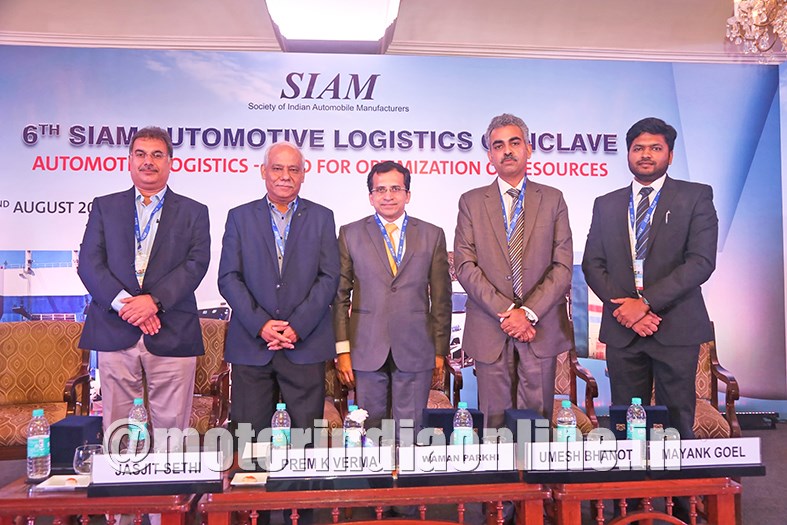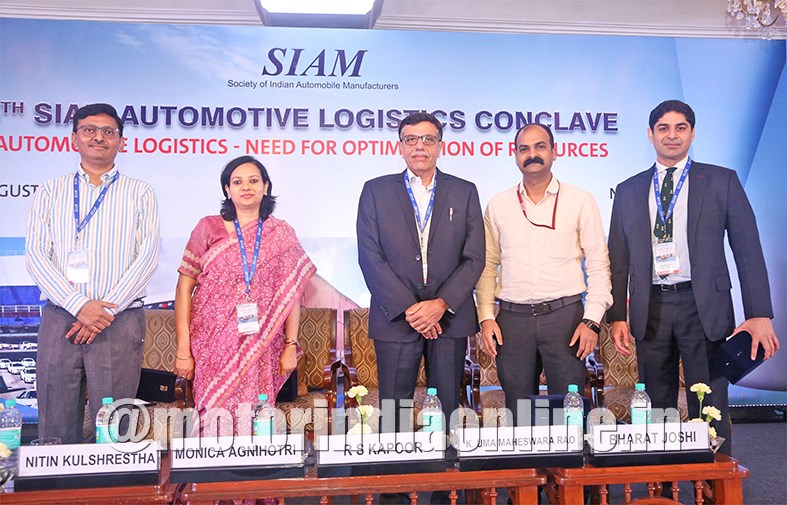The Society of Indian Automobile Manufacturers (SIAM) hosted the sixth edition of Automotive Logistics Conclave in New Delhi on August 1 and 2. Themed ‘Need for optimization of resources’, the conclave witnessed detailed discussions among logistics heads, suppliers and OEM heads to find solutions to optimize resources and mitigate gaps to facilitate industry growth.

Setting the tone for the conclave, Mr. Prem K. Verma, Chairman, SIAM Logistics Group, and Project Leader – Distribution & Logistics Strategy – Tata Motors, said at the inaugural session: “Our vision is to facilitate need-based interactions for developing a better understanding of automotive logistics and their requirements. The automotive industry wants to contribute over 12% of India’s GDP as a part of our vision for the Automotive Mission Plan (2016-26).”
Concluding his address, he asserted: “Undoubtedly, the cost of logistics in India is high, especially in automotive logistics where 96% of transportation is done on roads. To cut down costs, we need to eliminate the waste in the system to make it cost-competitive in the market. The Government needs to develop a policy and bring adequate infrastructure to promote multi-modal transportation in India.”
Delivering the keynote address, Mr. N. Sivasailam, Special Secretary, Department of Logistics, Ministry of Commerce, said: “It is time we started prioritising freight, for which I have also sought a policy shift. We need a system to track cargo shipments by having improved timetables to monitor the incoming and outgoing of ships. We also need to work closely with the Railway Ministry to make the operations profitable for licences. The inland port at Pandu has railway and road connectivity as well as a port facility which can provide immense opportunities for auto industry’s development and employment. Brahmaputra which is more than 900 km long offers huge scope for providing logistic solutions for movement of goods across domestic and international channels.”
He added: “When we talk about skilling drivers, we need to support the driver training institutions and also offer vehicle security. We should also focus on improving the condition of the drivers in the country, so that they can perform efficiently. Regarding the E-Way bill concern, we can ensure simplicity in its operations.”

The inaugural session concluded with Mr. B.C. Dutta, Vice President, Hyundai India, urging all the stakeholders to join hands, work together and find solutions to bring the economy back on the track, and help tackle the recession undergoing in the automobile industry.
The second session of day one talked about optimizing out-bound logistics. Chaired by Mr. Prem K. Verma, it highlighted the changes in the automotive sector. Mr. Arun Malhotra, Ex-MD, Nissan India, said: “GST and the E-Way bill have brought immense changes in the system. The E-way bill is a bottleneck that needs to be removed. When policies are being designed, there should be someone who addresses the challenges. Customers are adapting to changes and we need to follow the same path. With the License quota raj coming to an end, we foresee the trend of multi-national logistics partners penetrating the Indian market.”
Mr. Umesh Bhanot, MD, APL Logistics Vascor Automotive Pvt. Ltd., in his presentation, said: “When we talk about optimising out-bound logistics, it is important to recognise its various dimensions like finished vehicle logistics and after-market parts. Parameters of optimisation, as defined by OEMs, are the quality of processes, cost, delivery and the environmental impact. To achieve optimisation in transport mode, options available are roads (suited for short routes), rail (suited for long hauls), coastal shipping (for coast to coast movement) and finally export (a function of ocean freights). OEMs are also experimenting with various distribution models for optimisation of stockyards. Inter-modal rail is a viable transport mode to manage a service-sensitive, lean inventory of auto parts supply chain.”
Highlighting the importance of collaboration of all stakeholders, Mr. Jasjit Sethi, CEO, TCI Supply Chain Solutions, asserted: “For optimising out-bound logistics, we should consider LoT size (sell few, buy few), order to replenishment, mint condition, cost of logistics, network design, medium to long-term plans, and carrier optimisation. The only way to win is by working together and respecting the ecosystem.”
The second day of the conclave saw thought-provoking presentations made by Mr. R.S. Kapoor, Vice President, Maruti Suzuki India Ltd., Ms. Monica Agnihotri, Executive Director (Freight Marketing), Railway Board, Mr. K. Uma Maheshwar Rao, IRS, Joint General Manager, Dedicated Freight Corridor Corporation of India Ltd., Mr. Sanjay Bandopadhyaya, Additional Secretary, Ministry of Shipping, Mr. Shashi Bhushan Shukla, Member (Traffic), Inland Waterways Authority of India, Mr. D.K. Rai, Director, Chep India, and Mr. Tarun Garg, Executive Director, Maruti Suzuki India Ltd.
On the whole, the two-day conclave proved to be a fruitful one with enlightening sessions and panel discussions that highlighted the immense opportunities for logistics in roads, railways and waterways.